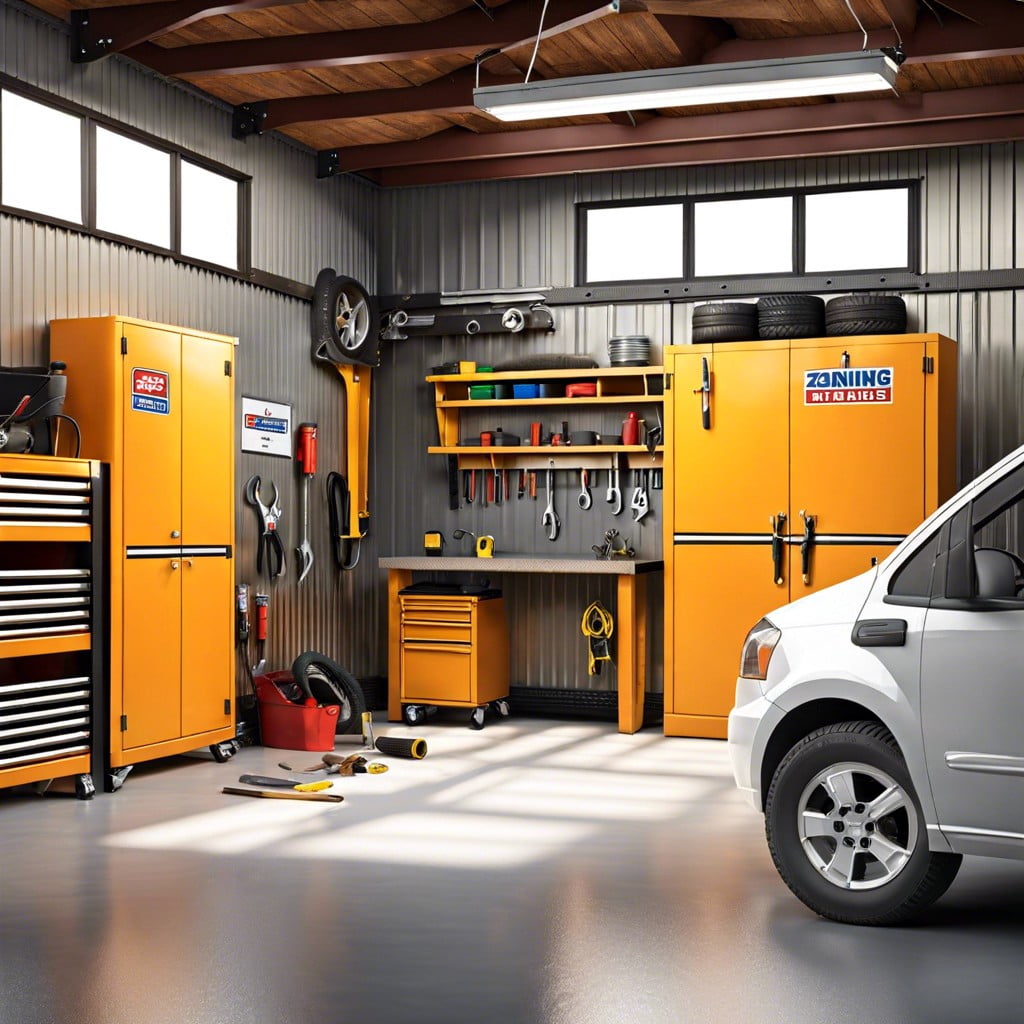Discover the essential services every auto repair garage should offer to keep your vehicle running smoothly.
Key takeaways:
- Zoning and permit compliance are crucial for opening an auto repair garage.
- Durable flooring options for auto repair garages include epoxy coatings and concrete sealers.
- Safety equipment and procedures are necessary to protect employees and customers.
- Environmental considerations include using eco-friendly practices and complying with waste management regulations.
- Technology integration, such as OBD-II scanners and management software, improves efficiency and customer satisfaction.
Zoning and Permit Compliance

Before breaking ground for an auto repair garage, it’s crucial to consult local zoning laws to ensure the chosen site is approved for automotive work. Zoning regulations determine the types of activities that can occur in specific areas; they serve to separate commercial functions from residential neighborhoods to minimize disturbances such as noise, traffic, and environmental impact.
Once a properly zoned location is secured, the next step is acquiring building permits. These are formal permissions from local government agencies that confirm the garage’s design meets building codes, safety standards, and, in some cases, aesthetic requirements. Permits are also essential for electrical, plumbing, and construction work, ensuring that all modifications are up to code and inspected for safety.
Failure to observe these regulations can lead to costly fines, legal action, or even the shutdown of business operations. Therefore, it’s advisable to engage with a knowledgeable local official or a specialist in commercial property development early in the process to navigate these administrative hurdles efficiently. Compliance not only safeguards the business owner but also ensures the safety and well-being of future employees and customers.
Flooring Materials
When selecting flooring for an auto repair garage, durability and resistance to chemicals are top priorities. Epoxy coatings, renowned for their tough nature, provide a high-gloss finish that can withstand the rigors of heavy machinery and chemical spills. They also facilitate easy cleaning of oil and other automotive fluids.
Another excellent option is concrete sealer, that enhances a concrete floor’s natural resistance to stains and abrasion. For those seeking an eco-friendly choice, polished concrete utilizes the existing concrete slab, eliminating the need for additional materials and offering a surface that easily repels automotive fluids.
Interlocking garage floor tiles offer a modular approach, allowing for damaged sections to be replaced without redoing the entire floor. These tiles are also slip-resistant and come in a variety of colors and patterns, enabling a custom look for the repair space.
Lastly, rubber flooring can provide a cushion underfoot, an advantage for mechanics who stand for long periods. It also acts as a noise dampener and offers excellent traction, reducing the risk of slips and falls in the workplace.
Safety Equipment and Procedures
Investing in high-quality safety equipment is essential for protecting both mechanics and clients in an auto repair garage. It starts with personal protective equipment (PPE) such as safety goggles, gloves, and steel-toed boots to safeguard against common hazards. Fire extinguishers should be placed at strategic locations, with different types for various fire classes, including electrical and combustible materials.
Proper ventilation systems are crucial to disperse harmful fumes from exhausts and chemicals. Installing emergency eye wash stations and showers is a precautionary measure for accidental exposure to hazardous substances.
Implementing a comprehensive safety training program ensures that every employee understands how to operate tools and machinery correctly. Regular drills should be conducted to rehearse protocols for fire, chemical spills, or other emergencies. It’s important to stay abreast of Occupational Safety and Health Administration (OSHA) guidelines to ensure compliance with federal and state safety regulations.
Finally, keeping a well-maintained floor free of oil spills, loose tools, or cords can significantly minimize the risk of slips and falls. Proper storage solutions for tools and parts not only increase efficiency but also eliminate potential trip hazards. Maintaining a clean and organized workspace is one of the simplest yet most effective safety strategies.
Environmental Considerations
Auto repair garages must adopt practices that minimize their environmental footprint. The use of water-based paints, for example, reduces the emission of volatile organic compounds (VOCs), harmful to both the atmosphere and human health. Implementing a comprehensive recycling program is also critical. This includes the proper disposal of oils, coolants, and batteries, along with the recycling of metal parts and tires.
Moreover, garages should install adequate ventilation systems to handle exhaust fumes and dust. Investing in updated equipment, like high-efficiency spray guns and paint booths, can lead to reductions in waste and energy consumption. Utilizing bioremediation methods for spill cleanups, which employ microorganisms to degrade hazardous substances into non-toxic compounds, is an innovative and eco-friendly approach.
Lastly, compliance with Environmental Protection Agency (EPA) guidelines ensures that all waste management procedures align with federal standards, averting detrimental impacts on soil and water sources. It’s also prudent to stay informed about local environmental regulations, which can vary and might have stricter requirements.
Technology Integration
Incorporating advanced technology into an auto repair garage enhances efficiency, accuracy, and customer satisfaction. Diagnostic equipment now leverages digital advancements to quickly pinpoint issues, saving time on manual inspections. Essential technology includes:
- OBD-II Scanners: Modern vehicles are equipped with onboard diagnostics. Updated scanners read complex codes and monitor real-time data.
- Management Software: Streamlines operations, from appointment scheduling to inventory control, and simplifies bookkeeping and customer communication.
- Digital Vehicle Inspections (DVI): Enable sending detailed inspection results, complete with images and videos, directly to a customer’s smartphone or email.
- LED Lighting: Provides brighter, more energy-efficient illumination, improving working conditions and reducing electricity costs.
Embracing these technologies positions a garage at the forefront of automotive service, offering precision and convenience that customers now expect.